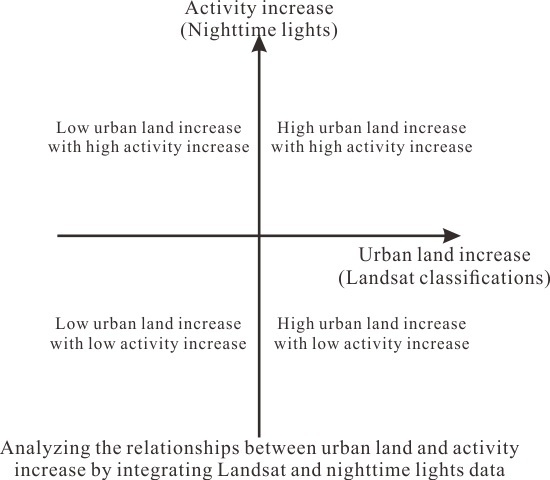Analyzing Parcel-Level Relationships between Urban Land Expansion and Activity Changes by Integrating Landsat and Nighttime Light Data
Abstract
:1. Introduction
2. Urban Land Expansion and Activity Changes
- High increase of urban land area with high increase of activity intensity (HH)
- High increase of urban land area with low increase of activity intensity (HL)
- Low increase of urban land area with high increase of activity intensity (LH)
- Low increase of urban land area with low increase of activity intensity (LL)
3. Study Area and Data
4. Results
4.1. Implementation of the Methodology
4.2. Relationships between Urban Land Expansion and Activity Changes
5. Discussion
6. Conclusions
Acknowledgments
Author Contributions
Conflicts of Interest
References
- United Nations. World Urbanization Prospects: The 2012 Revision; United Nations: New York, NY, USA, 2013. [Google Scholar]
- Zhang, Q.; Seto, K.C. Mapping urbanization dynamics at regional and global scales using multi-temporal DMSP/OLS nighttime light data. Remote Sens. Environ. 2011, 115, 2320–2329. [Google Scholar] [CrossRef]
- Ma, Y.; Xu, R. Remote sensing monitoring and driving force analysis of urban expansion in Guangzhou city, China. Habitat Int. 2010, 34, 228–235. [Google Scholar] [CrossRef]
- Seto, K.C.; Reenberg, A.; Boone, C.G.; Fragkias, M.; Haase, D.; Langanke, T.; Marcotullio, P.; Munroe, D.K.; Olah, B.; Simon, D. Urban land teleconnections and sustainability. Proc. Natl. Acad. Sci. USA 2012, 109, 7687–7692. [Google Scholar] [CrossRef] [PubMed]
- Myint, S.W.; Gober, P.; Brazel, A.; Grossman-Clarke, S.; Weng, Q. Per-pixel vs. Object-based classification of urban land cover extraction using high spatial resolution imagery. Remote Sens. Environ. 2011, 115, 1145–1161. [Google Scholar] [CrossRef]
- Pham, H.M.; Yamaguchi, Y. Urban growth and change analysis using remote sensing and spatial metrics from 1975 to 2003 for Hanoi, Vietnam. Int. J. Remote Sens. 2011, 32, 1901–1915. [Google Scholar] [CrossRef]
- Jin, S.; Yang, L.; Danielson, P.; Homer, C.; Fry, J.; Xian, G. A comprehensive change detection method for updating the National Land Cover Database to circa 2011. Remote Sens. Environ. 2013, 132, 159–175. [Google Scholar] [CrossRef]
- Li, X.; Gong, P.; Liang, L. A 30-year (1984–2013) record of annual urban dynamics of Beijing city derived from Landsat data. Remote Sens. Environ. 2015, 166, 78–90. [Google Scholar] [CrossRef]
- Deng, X.; Huang, J.; Rozelle, S.; Uchida, E. Economic growth and the expansion of urban land in China. Urban Stud. 2010, 47, 813–843. [Google Scholar] [CrossRef]
- Ma, T.; Zhou, C.; Pei, T.; Haynie, S.; Fan, J. Responses of SUOMI-NPP VIIRS-derived nighttime lights to socioeconomic activity in China’s cities. Remote Sens. Lett. 2014, 5, 165–174. [Google Scholar] [CrossRef]
- Chand, T.K.; Badarinath, K.; Elvidge, C.; Tuttle, B. Spatial characterization of electrical power consumption patterns over India using temporal DMSP-OLS night-time satellite data. Int. J. Remote Sens. 2009, 30, 647–661. [Google Scholar] [CrossRef]
- Shi, K.; Chen, Y.; Yu, B.; Xu, T.; Yang, C.; Li, L.; Huang, C.; Chen, Z.; Liu, R.; Wu, J. Detecting spatiotemporal dynamics of global electric power consumption using DMSP-OLS nighttime stable light data. Appl. Energy 2016, 184, 450–463. [Google Scholar] [CrossRef]
- Shi, K.; Yu, B.; Hu, Y.; Huang, C.; Chen, Y.; Huang, Y.; Chen, Z.; Wu, J. Modeling and mapping total freight traffic in china using NPP-VIIRS nighttime light composite data. GISci. Remote Sens. 2015, 52, 274–289. [Google Scholar] [CrossRef]
- Zhang, Q.; Schaaf, C.; Seto, K.C. The vegetation adjusted NTL urban index: A new approach to reduce saturation and increase variation in nighttime luminosity. Remote Sens. Environ. 2013, 129, 32–41. [Google Scholar] [CrossRef]
- Hsu, F.-C.; Baugh, K.E.; Ghosh, T.; Zhizhin, M.; Elvidge, C.D. DMSP-OLS radiance calibrated nighttime lights time series with intercalibration. Remote Sens. 2015, 7, 1855–1876. [Google Scholar] [CrossRef]
- Cao, Z.; Wu, Z.; Kuang, Y.; Huang, N.; Wang, M. Coupling an intercalibration of radiance-calibrated nighttime light images and land use/cover data for modeling and analyzing the distribution of GDP in Guangdong, China. Sustainability 2016, 8, 108. [Google Scholar] [CrossRef]
- Anselin, L. Local indicators of spatial association—LISA. Geogr. Anal. 1995, 27, 93–115. [Google Scholar] [CrossRef]
- Gray, D. District house price movements in England and Wales 1997–2007: An exploratory spatial data analysis approach. Urban Stud. 2012, 49, 1411–1434. [Google Scholar] [CrossRef]
- McGreal, S.; de La Paz, P.T.; Kupke, V.; Rossini, P.; Kershaw, P. Measuring the influence of space and time effects on time on the market. Urban Stud. 2015, 53, 2867–2884. [Google Scholar] [CrossRef]
- Leyk, S.; Ruther, M.; Buttenfield, B.P.; Nagle, N.N.; Stum, A.K. Modeling residential developed land in rural areas: A size-restricted approach using parcel data. Appl. Geogr. 2014, 47, 33–45. [Google Scholar] [CrossRef]
- Liu, Y.; Li, Z.; Liu, Y.; Chen, H. Growth of rural migrant enclaves in Guangzhou, China: Agency, everyday practice and social mobility. Urban Stud. 2015, 52, 3086–3105. [Google Scholar] [CrossRef]
- Anselin, L.; Syabri, I.; Kho, Y. GeoDa: An introduction to spatial data analysis. Geogr. Anal. 2006, 38, 5–22. [Google Scholar] [CrossRef]
- Chen, Y.; Li, X.; Liu, X.; Ai, B. Modeling urban land-use dynamics in a fast developing city using the modified logistic cellular automaton with a patch-based simulation strategy. Int. J. Geogr. Inf. Sci. 2014, 28, 234–255. [Google Scholar] [CrossRef]
- Liu, X.P.; Ma, L.; Li, X.; Ai, B.; Li, S.Y.; He, Z.J. Simulating urban growth by integrating landscape expansion index (LEI) and cellular automata. Int. J. Geogr. Inf. Sci. 2014, 28, 148–163. [Google Scholar] [CrossRef]
- Chen, Y.; Chang, K.-T.; Han, F.; Karacsonyi, D.; Qian, Q. Investigating urbanization and its spatial determinants in the central districts of Guangzhou, China. Habitat Int. 2016, 51, 59–69. [Google Scholar] [CrossRef]
- Shin, H.B. Unequal cities of spectacle and mega-events in China. City 2012, 16, 728–744. [Google Scholar] [CrossRef] [Green Version]
- Shin, H.B. Urban spatial restructuring, event-led development and scalar politics. Urban Stud. 2014, 51, 2961–2978. [Google Scholar] [CrossRef] [Green Version]
- Xu, J.; Yeh, A.G. City repositioning and competitiveness building in regional development: New development strategies in Guangzhou, China. Int. J. Urban Region. Res. 2005, 29, 283–308. [Google Scholar] [CrossRef] [Green Version]
- Wei, Y.; Zhao, M. Urban spill over vs. Local urban sprawl: Entangling land-use regulations in the urban growth of China’s megacities. Land Use Policy 2009, 26, 1031–1045. [Google Scholar]
- Zha, Y.; Gao, J.; Ni, S. Use of normalized difference built-up index in automatically mapping urban areas from TM imagery. Int. J. Remote Sens. 2003, 24, 583–594. [Google Scholar] [CrossRef]
- Ma, T.; Zhou, Y.; Wang, Y.; Zhou, C.; Haynie, S.; Xu, T. Diverse relationships between SUOMI-NPP VIIRS night-time light and multi-scale socioeconomic activity. Remote Sens. Lett. 2014, 5, 652–661. [Google Scholar] [CrossRef]
- Gong, J.; Liu, Y.; Xia, B. Spatial heterogeneity of urban land-cover landscape in Guangzhou from 1990 to 2005. J. Geogr. Sci. 2009, 19, 213–224. [Google Scholar] [CrossRef]
- Ng, M.K.; Xu, J. Second metamorphosis? Urban restructuring and planning responses in Guangzhou and Shenzhen in the twenty-first century. In Maturing Megacities; Springer: Berlin, Germany, 2014; pp. 29–60. [Google Scholar]
- Li, Z.; Li, X.; Wang, L. Speculative urbanism and the making of university towns in China: A case of Guangzhou university town. Habitat Int. 2014, 44, 422–431. [Google Scholar] [CrossRef]
- Wang, X.; Hui, E.C.; Choguill, C.; Jia, S. The new urbanization policy in China: Which way forward? Habitat Int. 2015, 47, 279–284. [Google Scholar] [CrossRef]
- Lin, G.C.; Yi, F. Urbanization of capital or capitalization on urban land? Land development and local public finance in urbanizing China. Urban Geogr. 2011, 32, 50–79. [Google Scholar] [CrossRef]
- Chang, G.H.; Brada, J.C. The paradox of China’s growing under-urbanization. Econ. Syst. 2006, 30, 24–40. [Google Scholar] [CrossRef]
- Yu, H. China’s “ghost cities”. East Asian Policy 2014, 6, 33–43. [Google Scholar] [CrossRef]
- Bagan, H.; Yamagata, Y. Landsat analysis of urban growth: How Tokyo became the world’s largest megacity during the last 40 years. Remote Sens. Environ. 2012, 127, 210–222. [Google Scholar] [CrossRef]
- Shi, K.; Yu, B.; Huang, Y.; Hu, Y.; Yin, B.; Chen, Z.; Chen, L.; Wu, J. Evaluating the ability of NPP-VIIRS nighttime light data to estimate the gross domestic product and the electric power consumption of China at multiple scales: A comparison with DMSP-OLS data. Remote Sens. 2014, 6, 1705–1724. [Google Scholar] [CrossRef]
- Chen, Y.; Li, X.; Liu, X.; Ai, B. Analyzing land-cover change and corresponding impacts on carbon budget in a fast developing sub-tropical region by integrating MODIS and Landsat TM/ETM+ images. Appl. Geogr. 2013, 45, 10–21. [Google Scholar] [CrossRef]
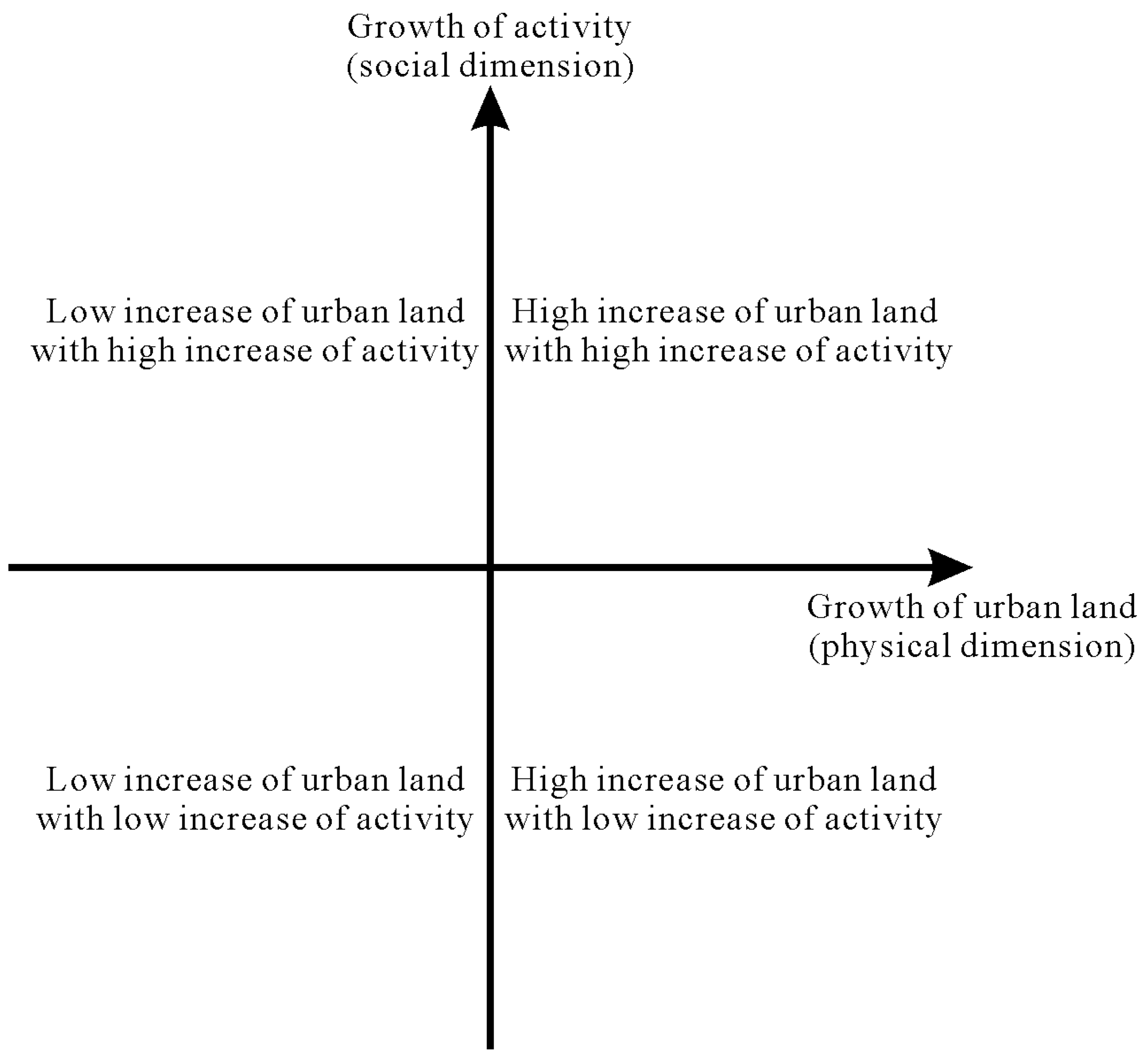
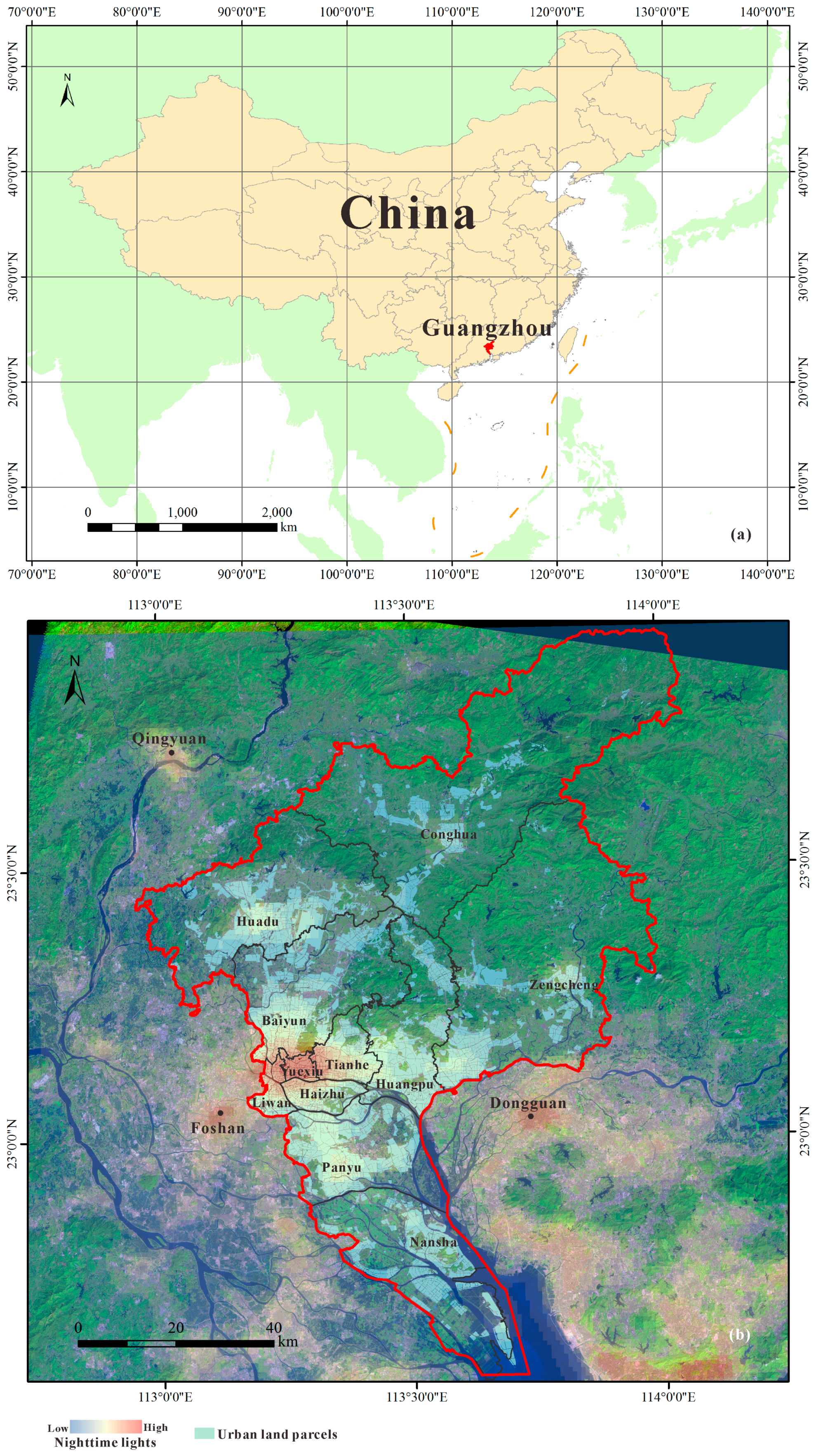
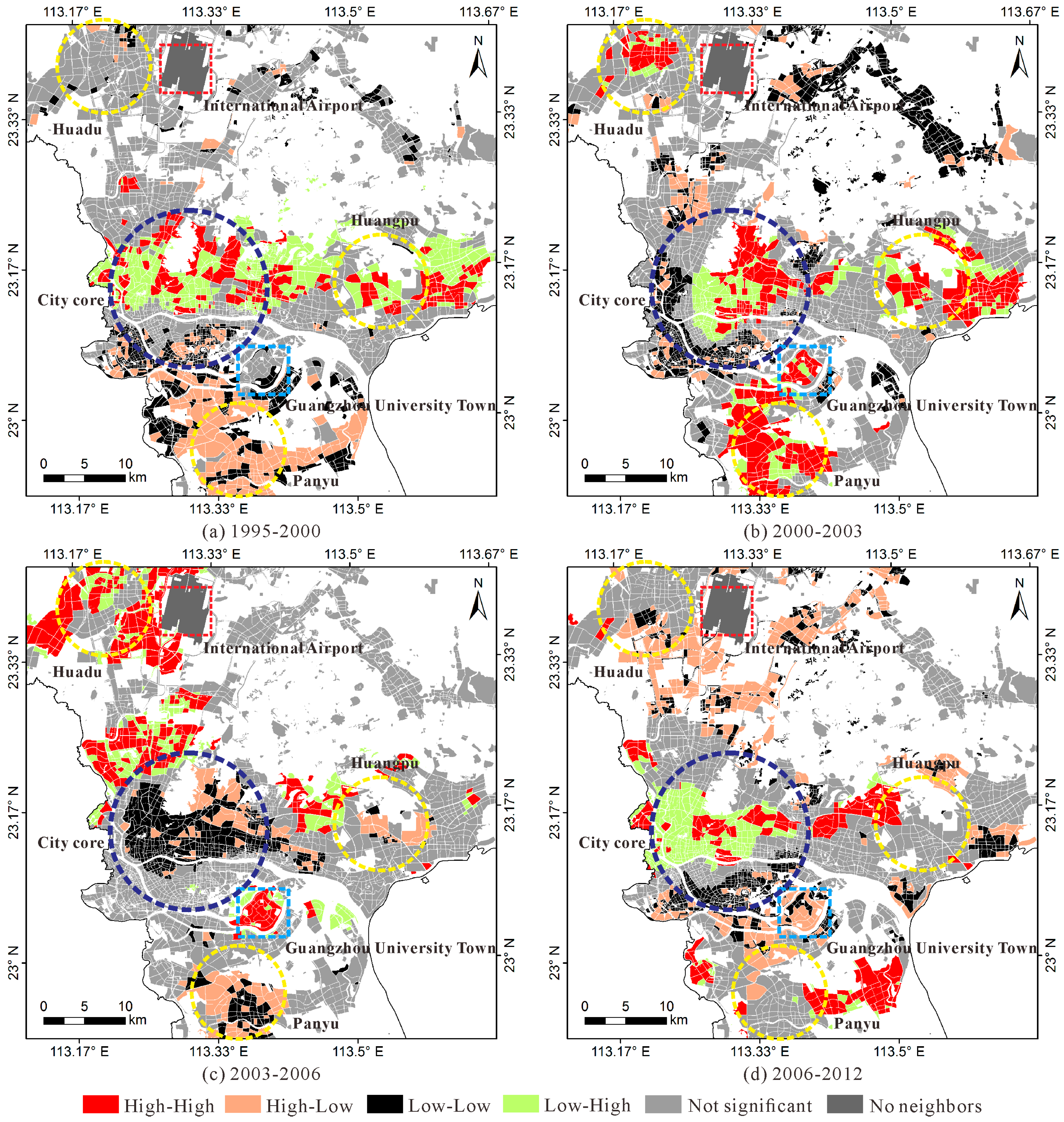
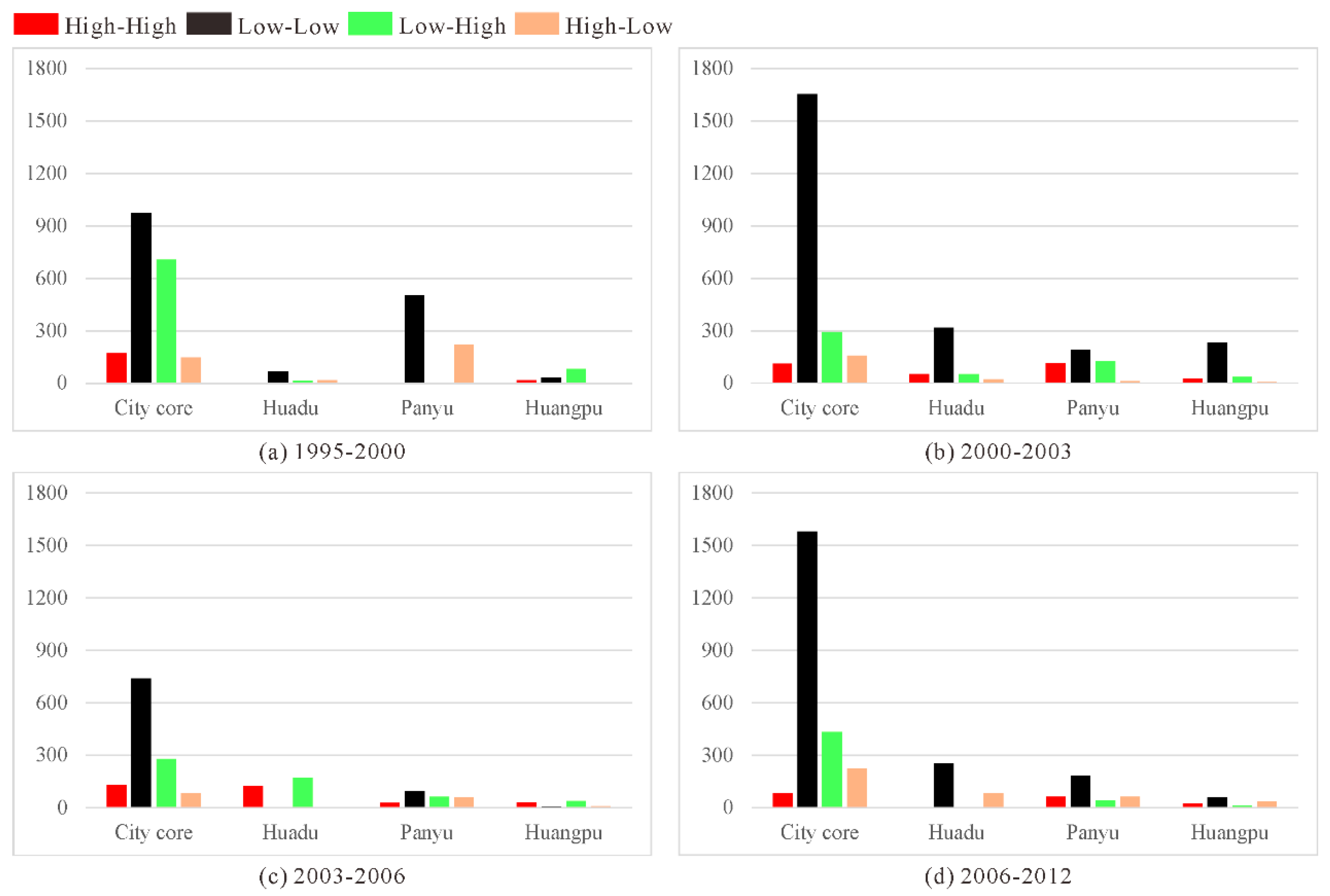
| Acquisition Dates of the Landsat Images | Global Radiance Calibrated Nighttime Lights |
|---|---|
| 1995.12.30 (Landsat 5 TM) | F12_19960316-19970212_rad_v4 |
| 2000.11.01 (Landsat 7 ETM+) | F12-F15_20000103-20001229_rad_v4 |
| 2003.12.20 (Landsat 5 TM) | F14-F15_20021230-20031127_rad_v4 |
| 2006.12.04 (Landsat 7 ETM+) | F16_20051128-20061224_rad_v4 |
| 2012.11.02 (Landsat 7 ETM+) | F16_20100111-20110731_rad_v4 |
| Year | Object Count | NDBI | Accuracy (Before Correction) | Accuracy (After Correction) |
|---|---|---|---|---|
| 1995 | 169,153 | [0.0957, 0.3465] | 78.88% | 92.10% |
| 2000 | 225,882 | [0.0600, 0.3295] | 79.00% | 94.89% |
| 2003 | 211,519 | [0.1024, 0.2284] | 77.10% | 94.63% |
| 2006 | 220,185 | [0.1117, 0.2381] | 74.63% | 95.77% |
| 2012 | 243,001 | [0.1474, 0.2962] | 79.74% | 98.45% |
| Products | β0 | β1 |
|---|---|---|
| F12_19960316-19970212_rad_v4 | 4.336 | 0.915 |
| F12-F15_20000103-20001229_rad_v4 | 3.658 | 0.710 |
| F14-F15_20021230-20031127_rad_v4 | 3.736 | 0.797 |
| F16_20100111-20110731_rad_v4 | –1.987 | 1.246 |
| Residential | Shopping | Company | Factory | Constant | |
|---|---|---|---|---|---|
| Coefficient | 7.46 *** | 101.01 *** | 63.10 *** | 4.05 ** | −23.40 ** |
| Standardized coefficient | 0.11 *** | 0.40 *** | 0.51 *** | 0.07 ** | -- |
| t-statistics | 3.33 | 11.70 | 18.56 | 2.50 | −2.83 |
| Liwan | Yuexiu | Haizhu | Tianhe | Baiyun | Panyu | Huadu | |
|---|---|---|---|---|---|---|---|
| GDP (103 million yuan) | |||||||
| 2001 | 23,647.62 | 49,677.38 | 21,929.46 | 29,773.26 | 30,970.93 | 31,792.01 | 16,722.03 |
| 2003 | 29,793.78 | 59,598.64 | 27,144.31 | 36,468.18 | 43,633.51 | 41,478.47 | 22,113.83 |
| 2006 | 34,479.22 | 94,499.11 | 31,301.00 | 94,295.70 | 52,690.84 | 49,158.58 | 32,455.51 |
| 2012 | 60,713.22 | 172,681.4 | 81,405.94 | 195,534.1 | 96,514.07 | 94,718.94 | 65,131.26 |
| Average Growth Rate (%) | |||||||
| 2001–2003 | 12.25 | 9.53 | 11.26 | 10.67 | 18.70 | 11.55 | 12.31 |
| 2003–2006 | 4.99 | 16.61 | 4.86 | 37.25 | 6.49 | 5.83 | 13.64 |
| 2006–2012 | 9.89 | 10.57 | 17.27 | 12.92 | 10.61 | 14.22 | 15.00 |
© 2017 by the authors. Licensee MDPI, Basel, Switzerland. This article is an open access article distributed under the terms and conditions of the Creative Commons Attribution (CC BY) license ( http://creativecommons.org/licenses/by/4.0/).
Share and Cite
Chen, Y.; Liu, X.; Li, X. Analyzing Parcel-Level Relationships between Urban Land Expansion and Activity Changes by Integrating Landsat and Nighttime Light Data. Remote Sens. 2017, 9, 164. https://doi.org/10.3390/rs9020164
Chen Y, Liu X, Li X. Analyzing Parcel-Level Relationships between Urban Land Expansion and Activity Changes by Integrating Landsat and Nighttime Light Data. Remote Sensing. 2017; 9(2):164. https://doi.org/10.3390/rs9020164
Chicago/Turabian StyleChen, Yimin, Xiaoping Liu, and Xia Li. 2017. "Analyzing Parcel-Level Relationships between Urban Land Expansion and Activity Changes by Integrating Landsat and Nighttime Light Data" Remote Sensing 9, no. 2: 164. https://doi.org/10.3390/rs9020164




